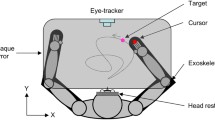Abstract.
Since normal human subjects can perform smooth-pursuit eye movements only in the presence of a moving target, the occurrence of these eye movements represents an ideal behavioural probe to monitor the successful processing of visual motion. It has been shown previously that subjects can execute smooth-pursuit eye movements to targets defined by luminance and colour, the first-order stimulus attributes, as well as to targets defined by derived, second-order stimulus attributes such as contrast, flicker or motion. In contrast to these earlier experiments focusing on steady-state pursuit, the present study addressed the course of pre-saccadic pursuit initiation (less than 100 ms), as this early time period is thought to represent open-loop pursuit, i.e. the eye movements are exclusively driven by visual inputs proceeding the onset of the eye movement itself. Eye movements of five human subjects tracking first- and second-order motion stimuli had been measured. The analysis of the obtained eye traces revealed that smooth-pursuit eye movements could be initiated to first-order as well as second-order motion stimuli, even before the execution of the first initial saccade. In contrast to steady-state pursuit, the initiation of pursuit was not exclusively determined by the movement of the target, but rather due to an interaction between dominant first-order and less-weighted second-order motion components. Based on our results, two conclusions may be drawn: first and specific for initiation of smooth-pursuit eye movements, we present evidence supporting the notion that initiation of pursuit reflects integration of all available visual motion information. Second and more general, our results further support the hypothesis that the visual system consists of more than one mechanism for the extraction of first-order and second-order motion.
Similar content being viewed by others
Author information
Authors and Affiliations
Additional information
Electronic Publication
Rights and permissions
About this article
Cite this article
Lindner, A., Ilg, U. Initiation of smooth-pursuit eye movements to first-order and second-order motion stimuli. Exp Brain Res 133, 450–456 (2000). https://doi.org/10.1007/s002210000459
Received:
Accepted:
Issue Date:
DOI: https://doi.org/10.1007/s002210000459




